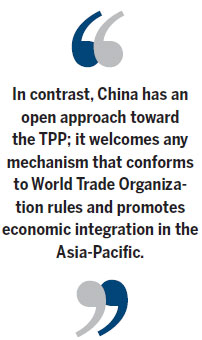Challenge of US-led trade pact can be overcome
Updated: 2015-11-20 08:08
By Xu Man(China Daily Europe)
|
|||||||||||
TPP gives China good reason to begin working more closely with ASEAN
Twelve countries have signed the Trans-Pacific Partnership Agreement, but it is too early to gauge how it will affect China's economy, because the huge development differences between TPP members mean it will take them a long time to fully implement the agreement.
However, high standards and new rules for state-owned enterprises, environmental protection, labor and intellectual property suggest the agreement, once it becomes fully operational, will not only put pressure on China to diversify its trade but also significantly influence the trading system in the Asia-Pacific region and beyond.
So China needs to step up its efforts to bring about regional economic integration. Since member states of the Association of Southeast Asian Nations are strategically located on the 21st Century Maritime Silk Road, China should work more closely with these countries - in particular Singapore, Malaysia, Brunei and Vietnam, which have signed the TPP Agreement - to forge a closer community of shared interests in the region.
By signing on to the TPP, together with its efforts to negotiate the Transatlantic Trade and Investment Partnership, the United States seems to be building a new trade and investment regime that excludes China.
US President Barack Obama has gone all out to make the TPP a major achievement of his presidency and a core part of his "pivot to Asia-Pacific" strategy. Although the White House has repeatedly said the agreement is not aimed at containing China, the words China and geopolitics were ubiquitous when Congress was being lobbied to fast-track passage of the deal.

In a recent report on the US' China policy, the Council on Foreign Relations described the agreement as a great strategy to counter China's rise. And in a statement issued on the day agreement on the pact was announced, Obama said the US should not let countries like China write the rules of the world economy.
In contrast, China has an open approach toward the TPP; it welcomes any mechanism that conforms to World Trade Organization rules and promotes economic integration in the Asia-Pacific. China is trying to create a more equitable and open environment for competition through comprehensive reform. Therefore, it could consider joining the TPP and work more closely with the US if the conditions are right.
There are also concerns in ASEAN over the agreement's negative consequences. Some ASEAN members are worried that in belonging to the partnership, Vietnam and Malaysia will help benefit from the transfer of US and Japanese production lines. This, they fear, will reduce the chances of Cambodia and Laos joining the global industrial chain, further widening the development gap in ASEAN, and thus hampering its economic integration.
These developments should prompt China to work more closely with ASEAN to build the Regional Comprehensive Economic Partnership, an initiative that is appropriate for dealing with ASEAN's realities, such as uneven development, and accords it the leading role in promoting regional cooperation. Hopefully, the upgraded talks on a China-ASEAN free trade area, once completed by the end of this month, will usher in a diamond decade for all sides.
The 21st Century Maritime Silk Road, proposed by President Xi Jinping during his visit to ASEAN countries in 2013, has no threshold or standards for participation. It is aimed at dovetailing China's development policies with those of other countries irrespective of their development levels to better serve the common interests of all participants.
China has formed economic and trade cooperation zones with Vietnam, Indonesia, Cambodia and Thailand, which are located along the 21st Century Maritime Silk Road. Such zones have indeed strengthened their economic relations, but there is still room for improving ties with other ASEAN member states in numerous fields.
The opportunities brought about by China's efforts to push for interconnectivity among countries along the 21st Century Maritime Silk Road are expected to result in it working more closely with ASEAN members, especially those that need financing and technologies to modernize their infrastructure.
The author is a researcher with the Chinese Academy of International Trade and Economic Cooperation, affiliated to the Ministry of Commerce. The views do not necessarily reflect those of China Daily.
(China Daily European Weekly 11/20/2015 page13)
Today's Top News
Suspected mastermind of Paris attacks died
Xi condemns murder of man taken hostage by IS
'Schweppes bomb' used to bring down Russian plane
Paris suburb raid targets suspected attack mastermind
France, Russia launch more strikes against IS
England fans sing French national anthem
France requests European support in Mid East
Hollande pressed to amend foreign policy
Hot Topics
Lunar probe , China growth forecasts, Emission rules get tougher, China seen through 'colored lens', International board,
Editor's Picks

|

|

|

|

|

|






